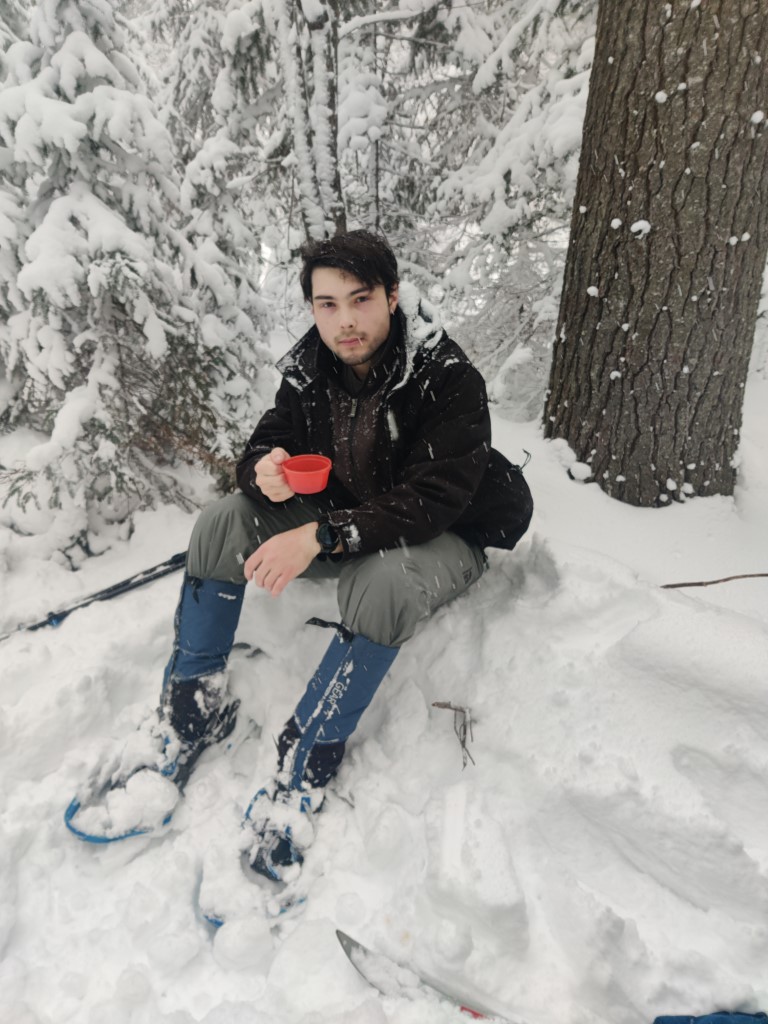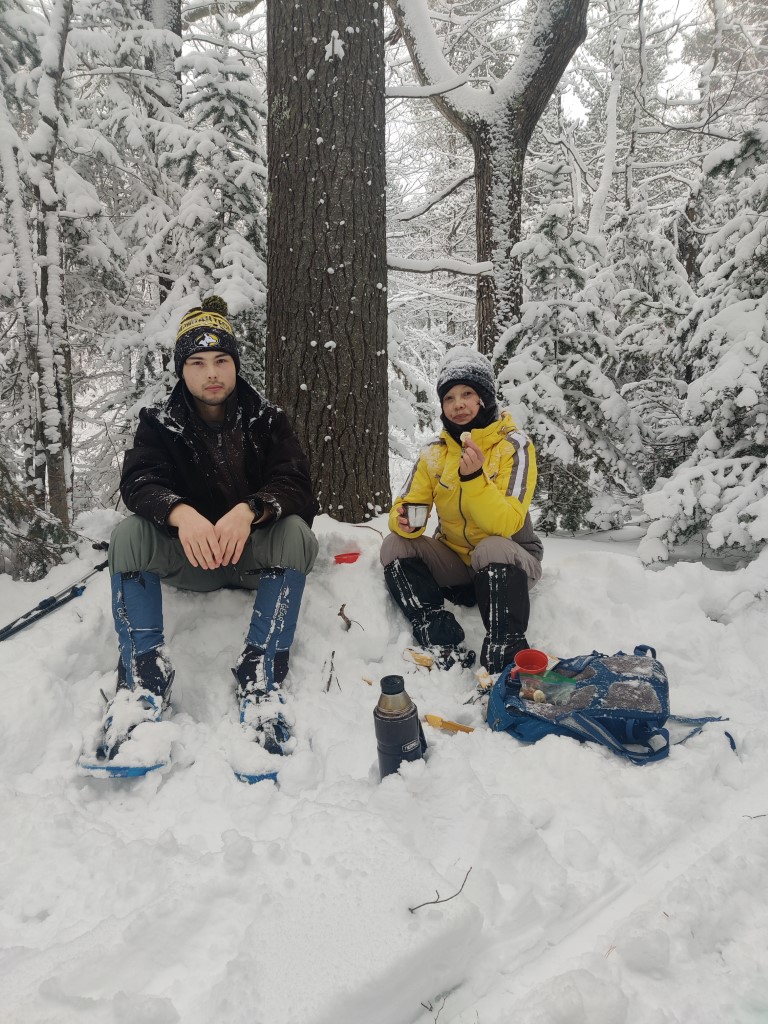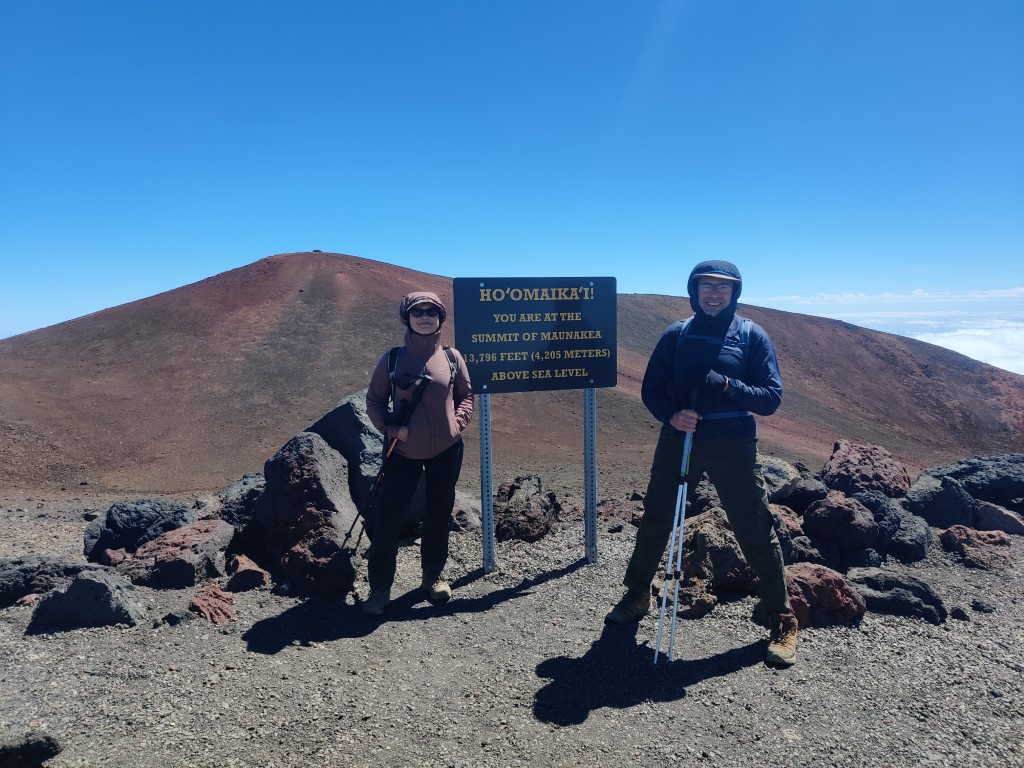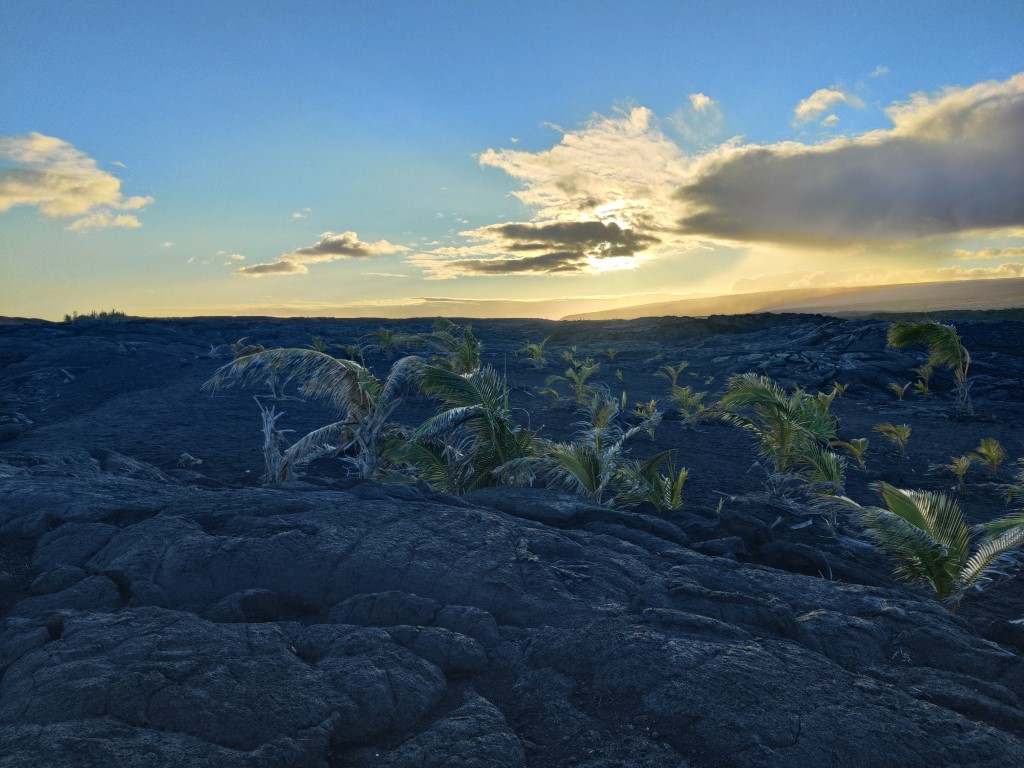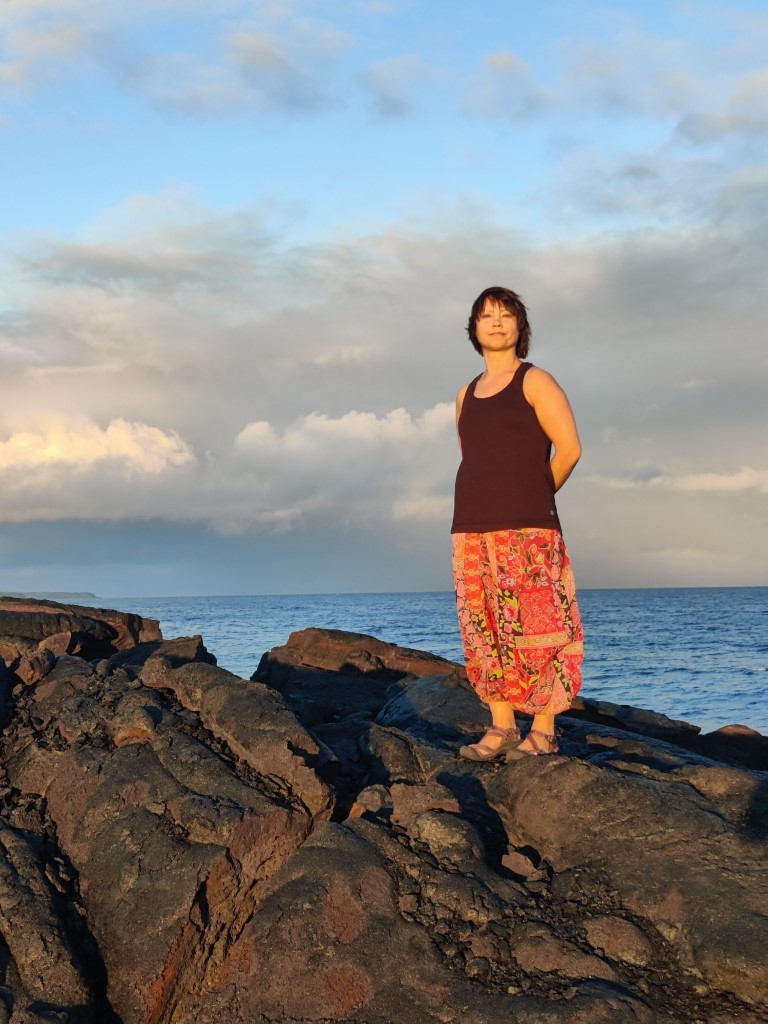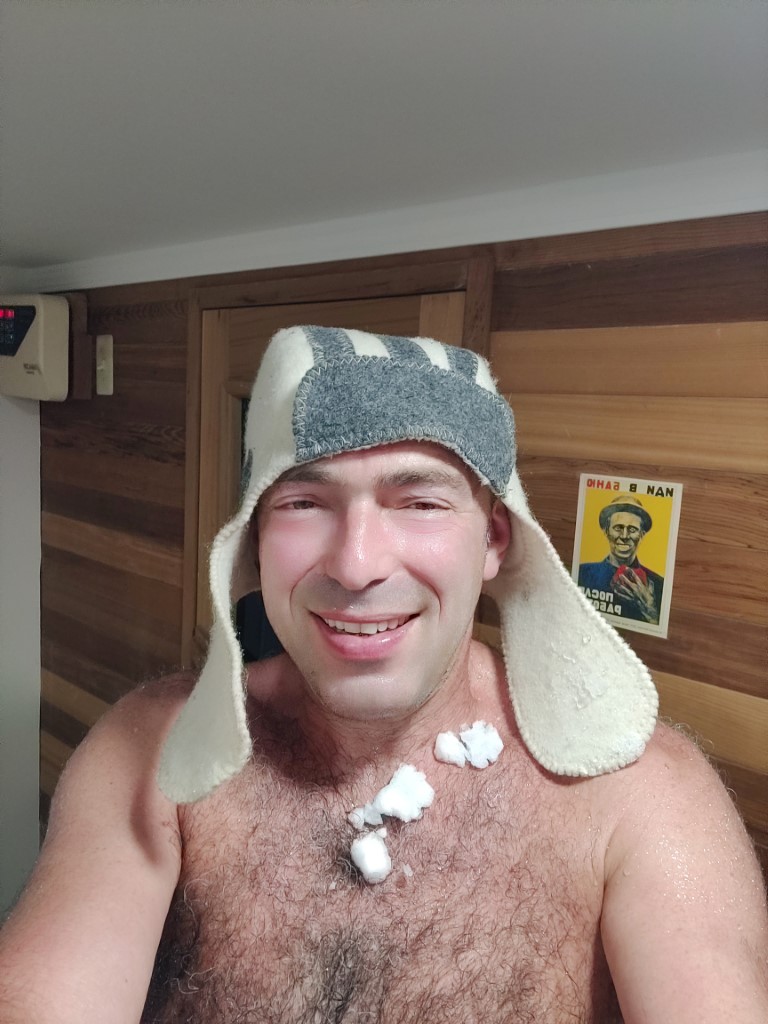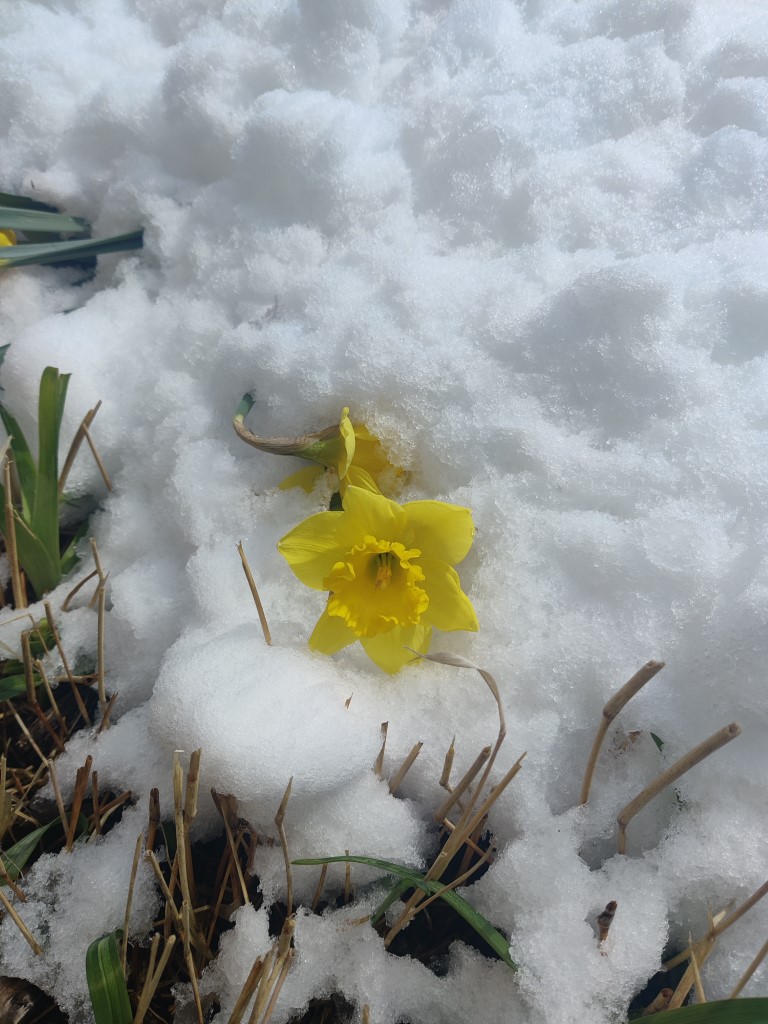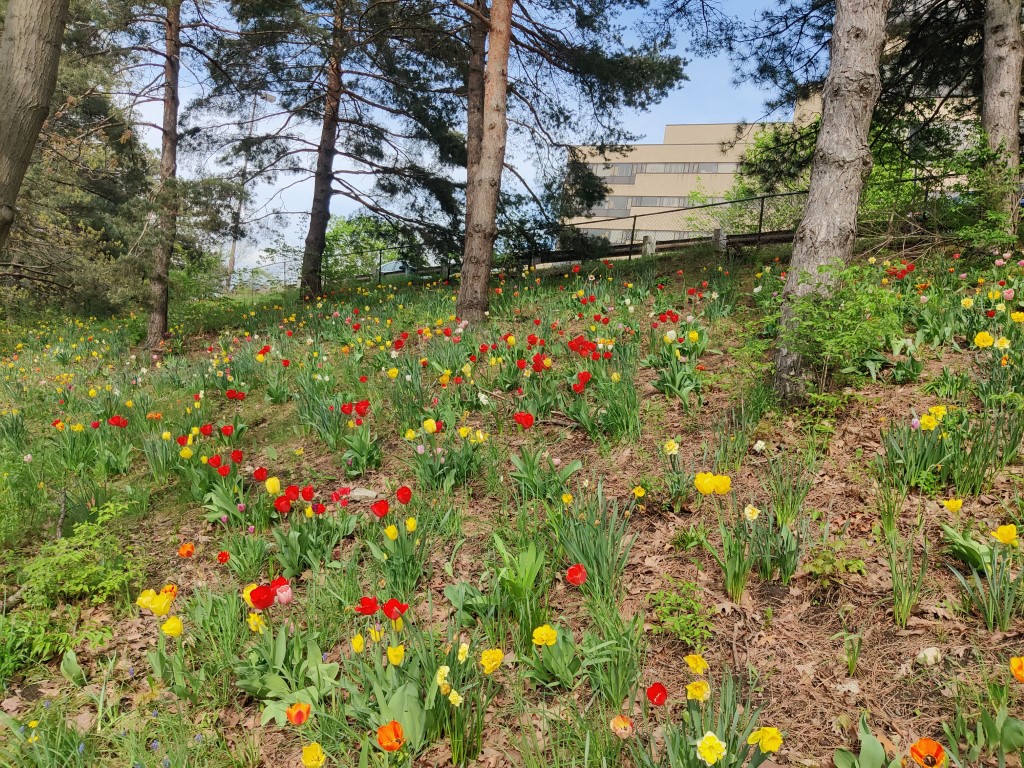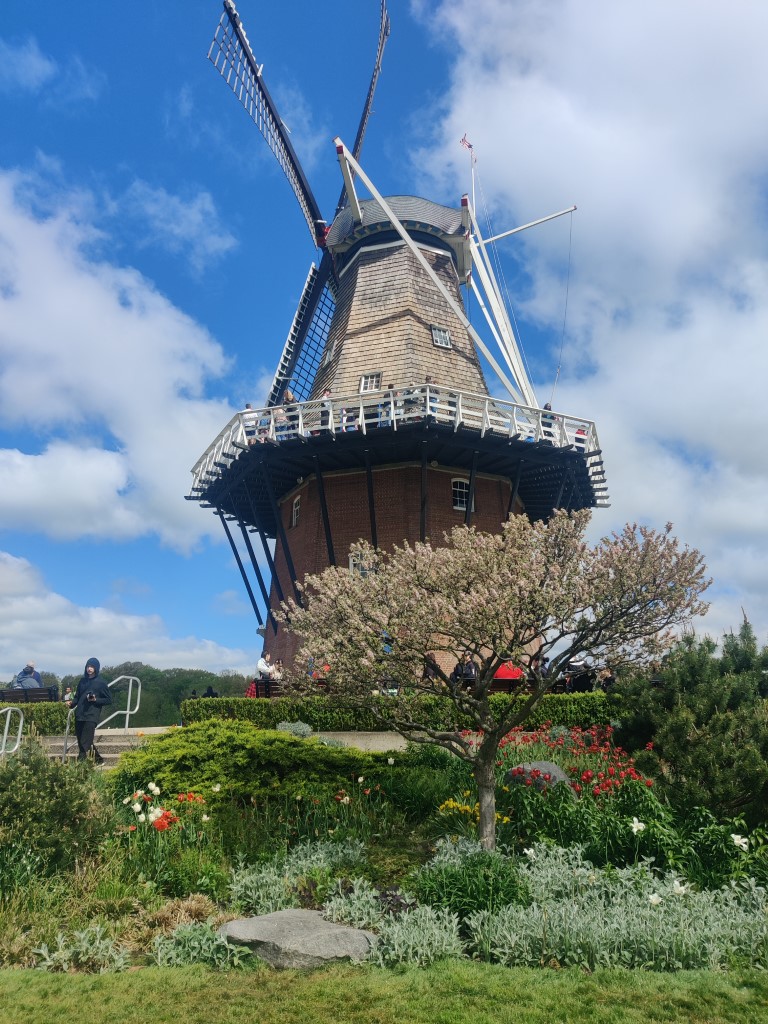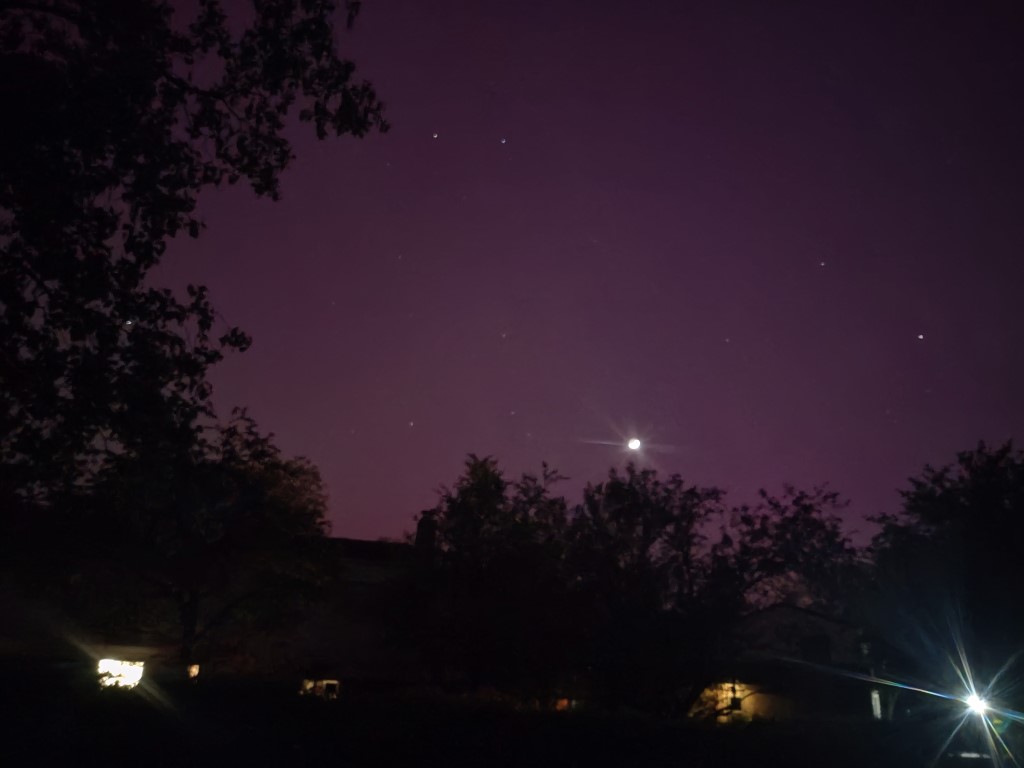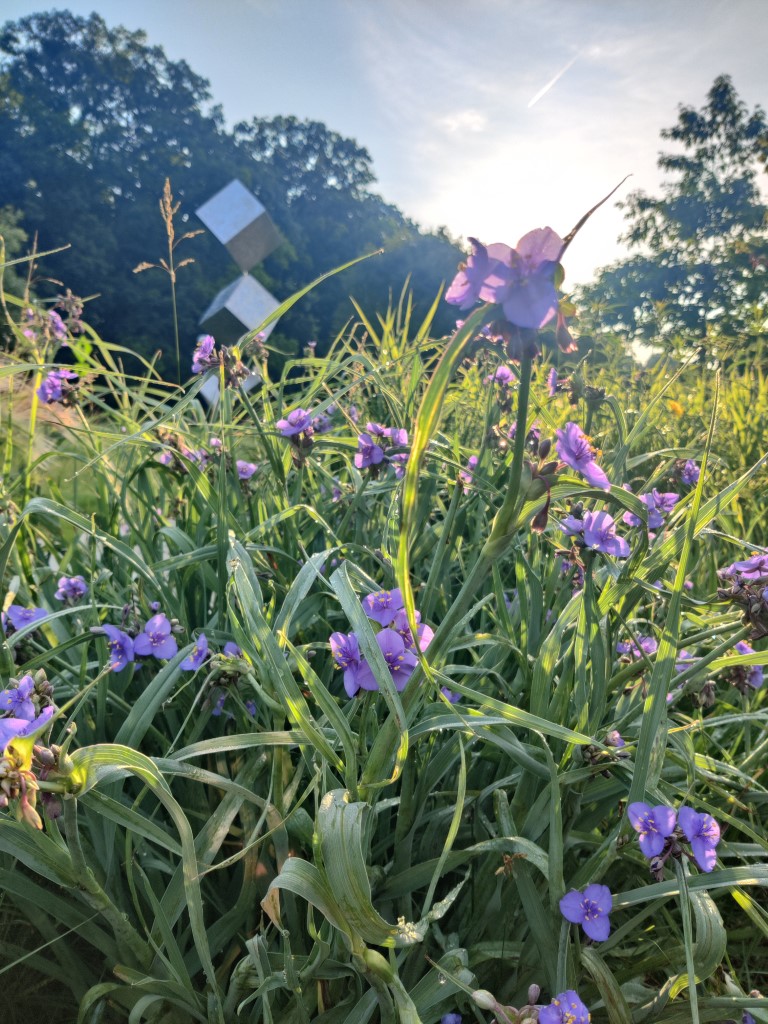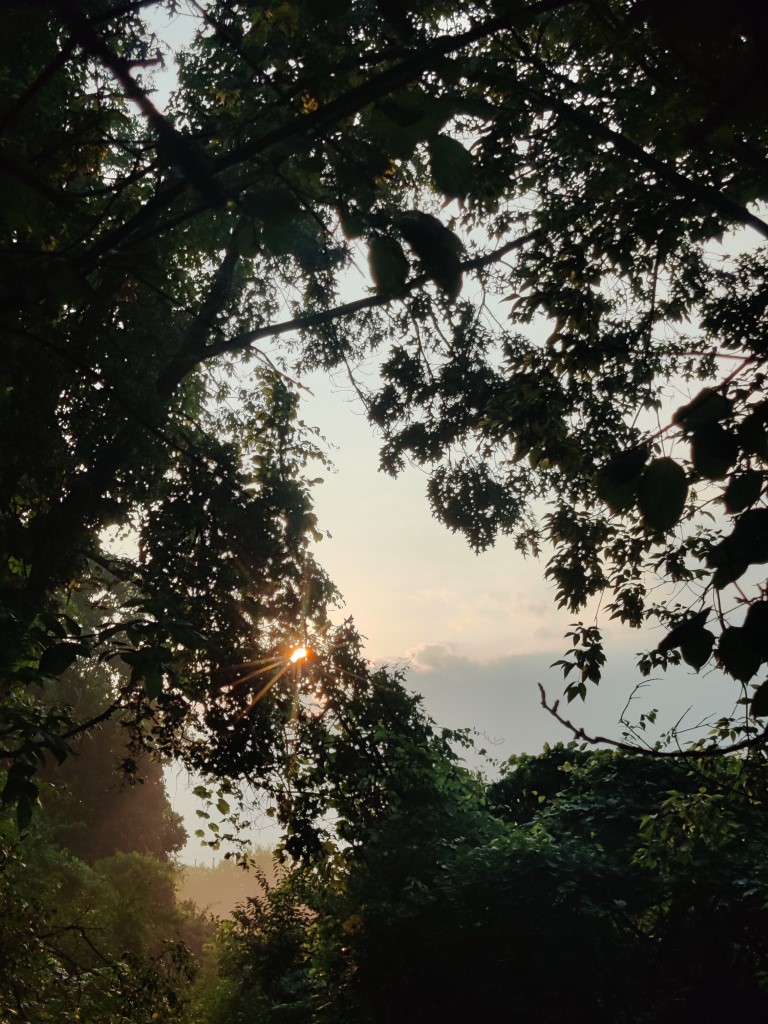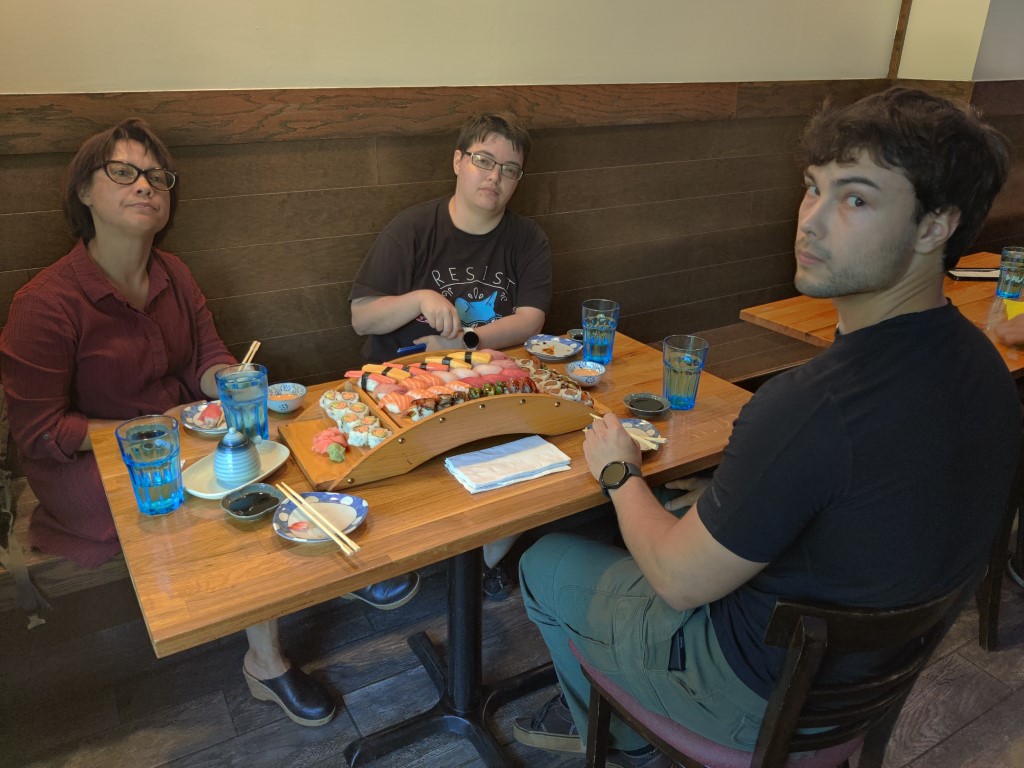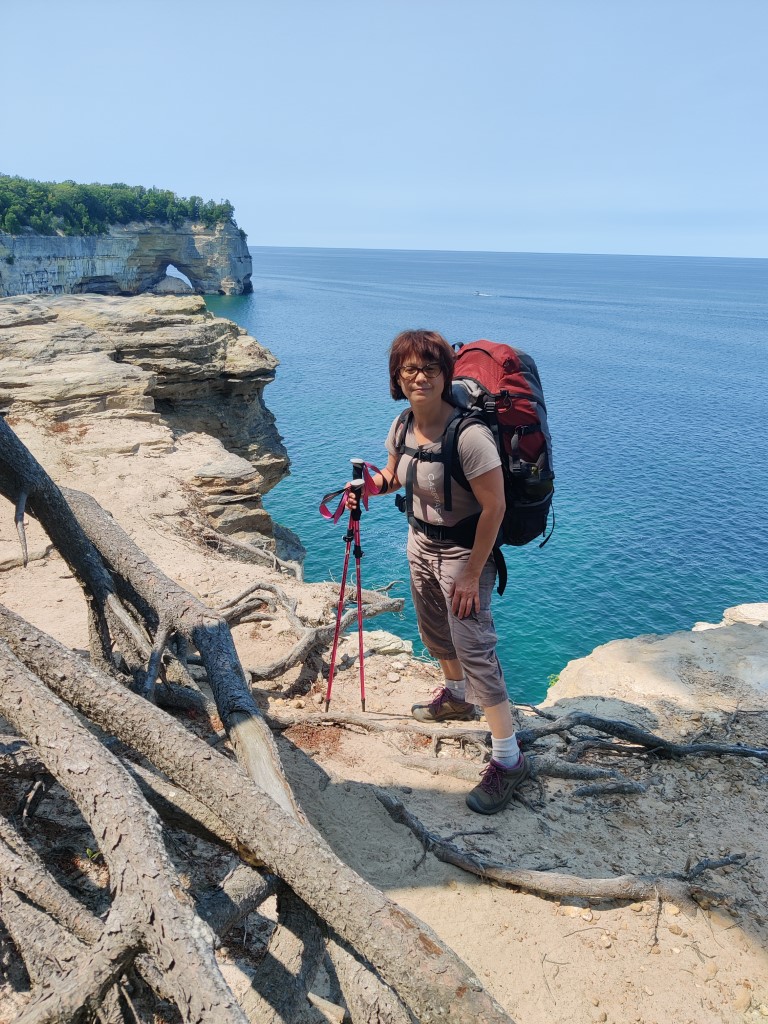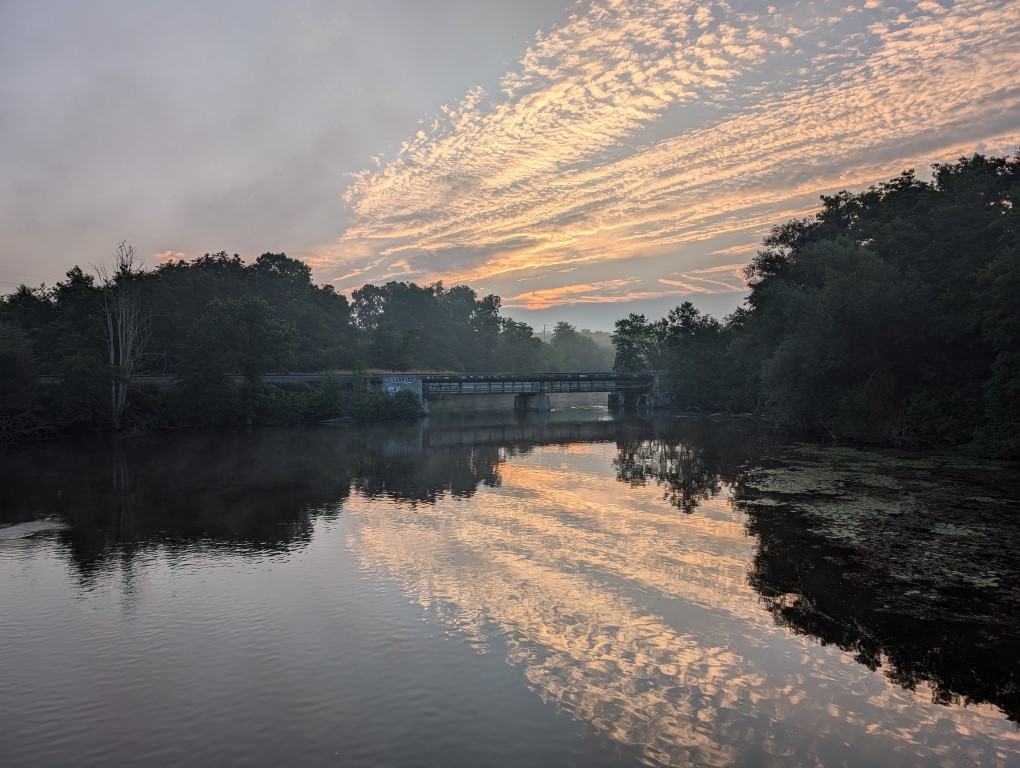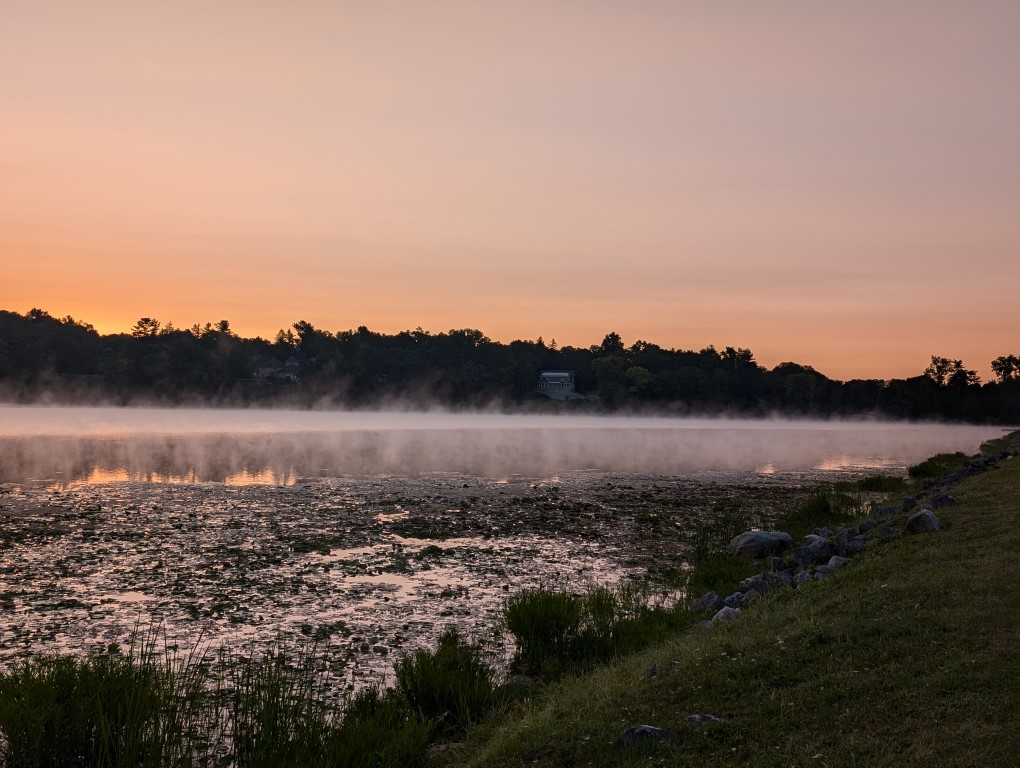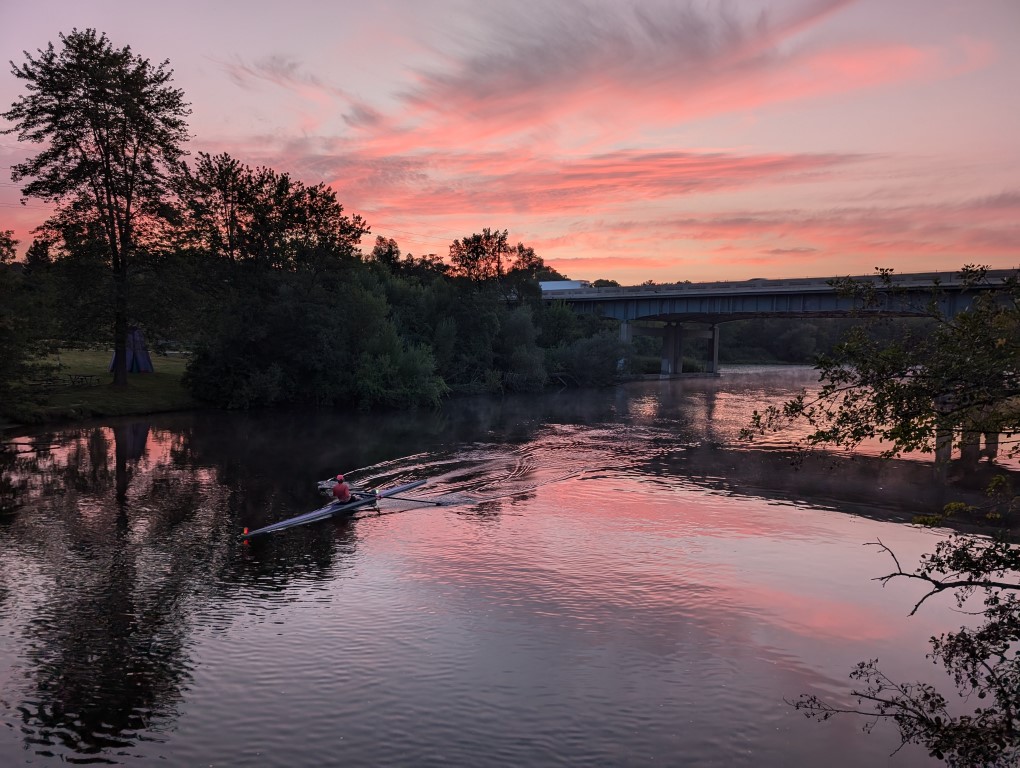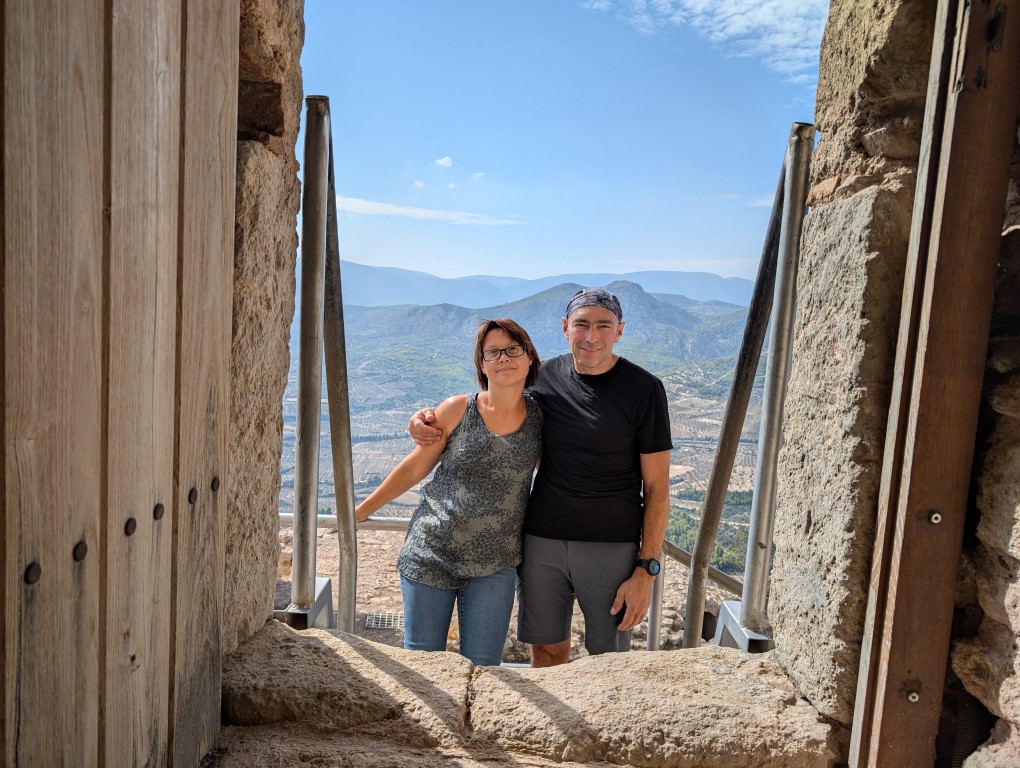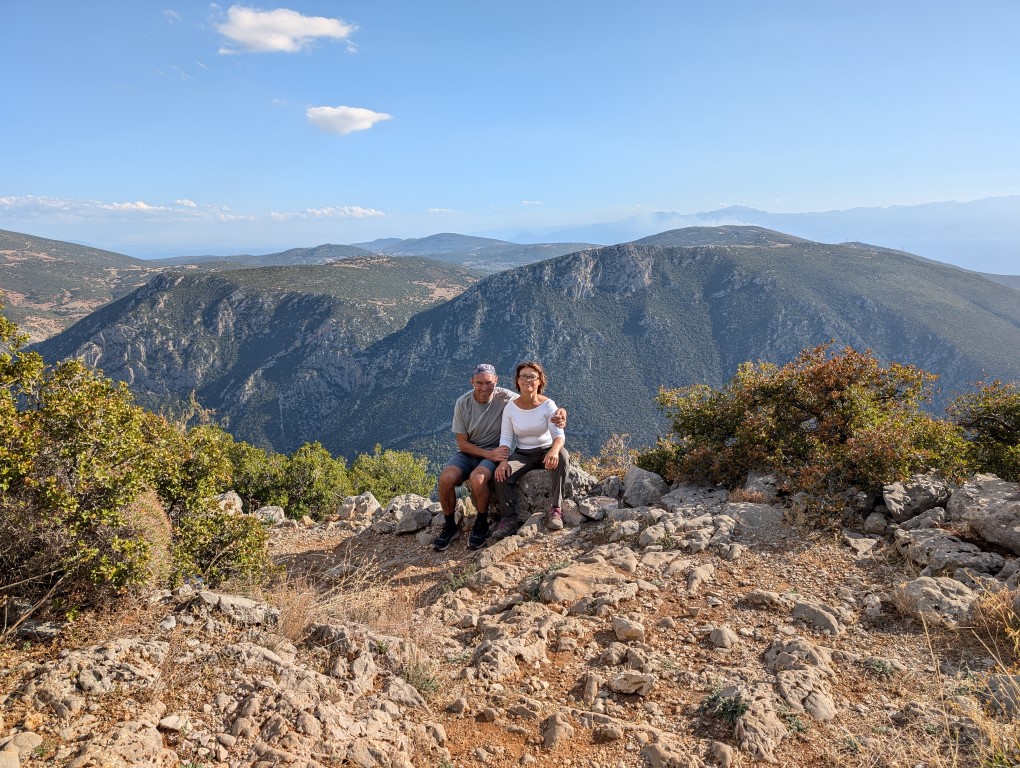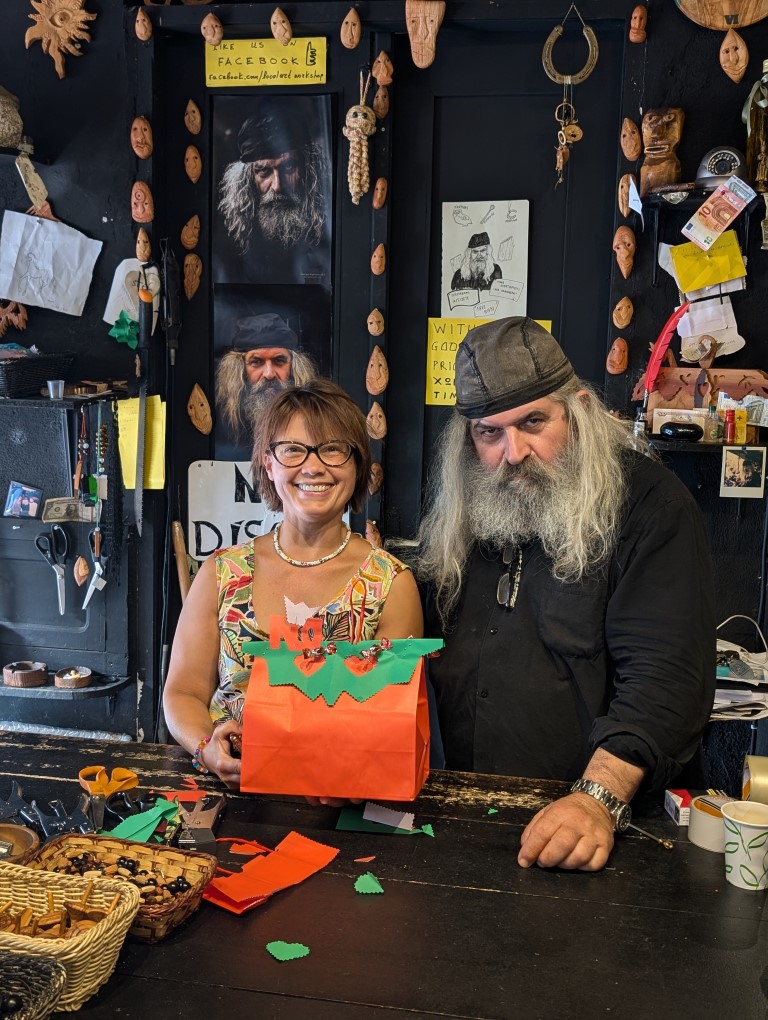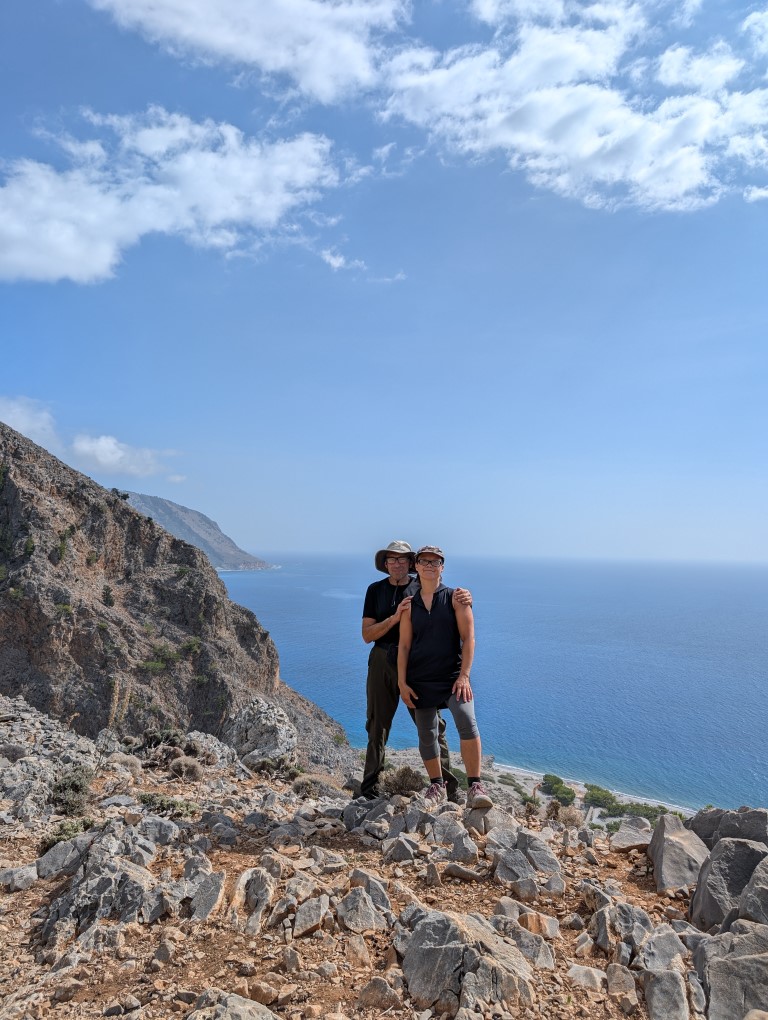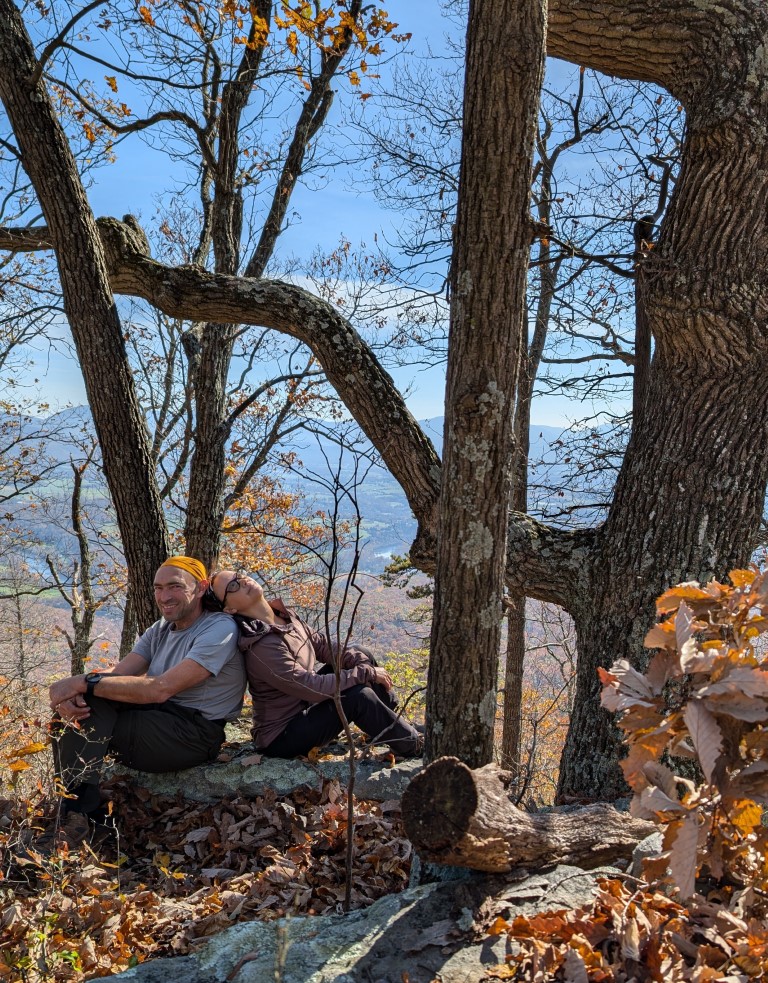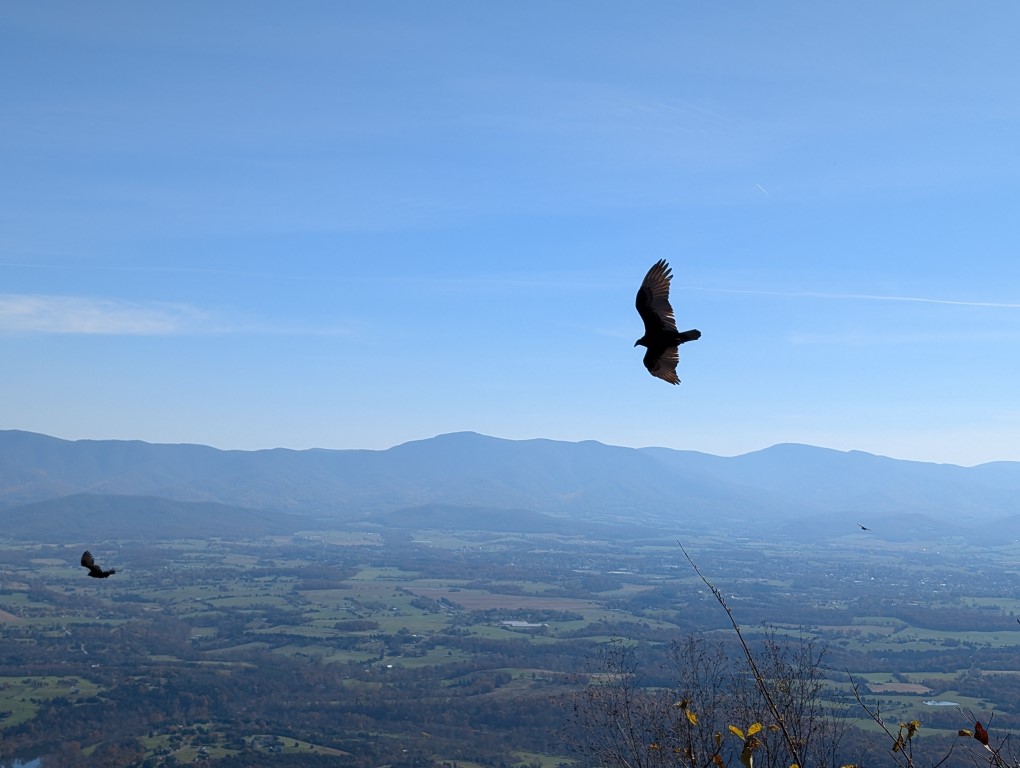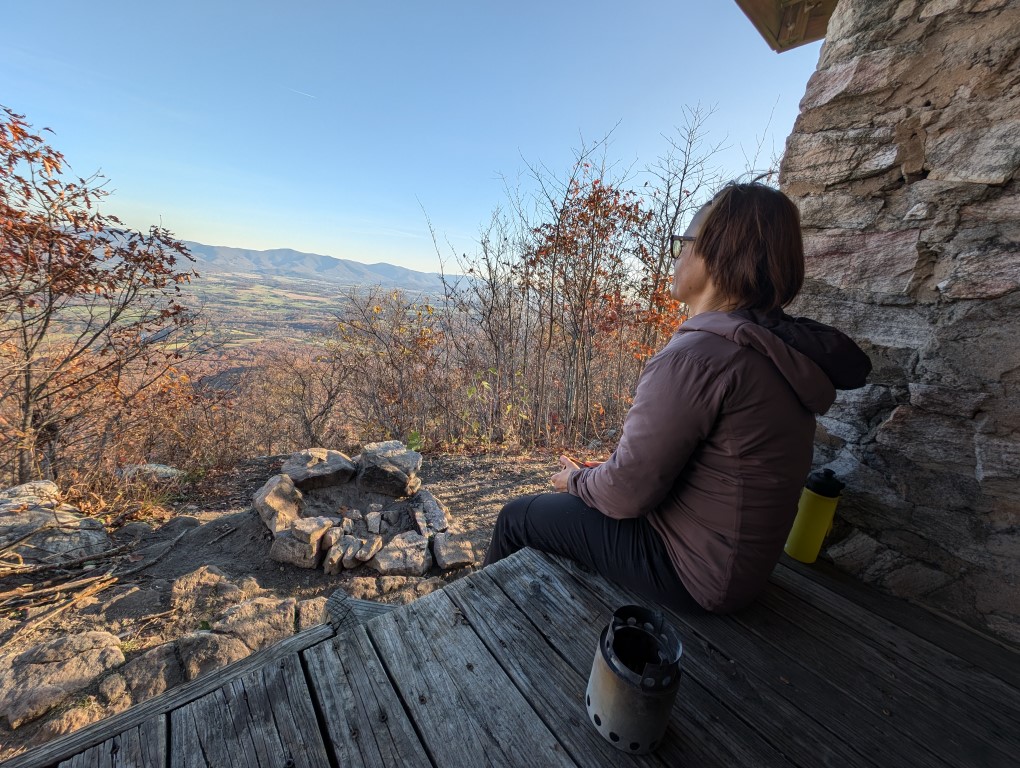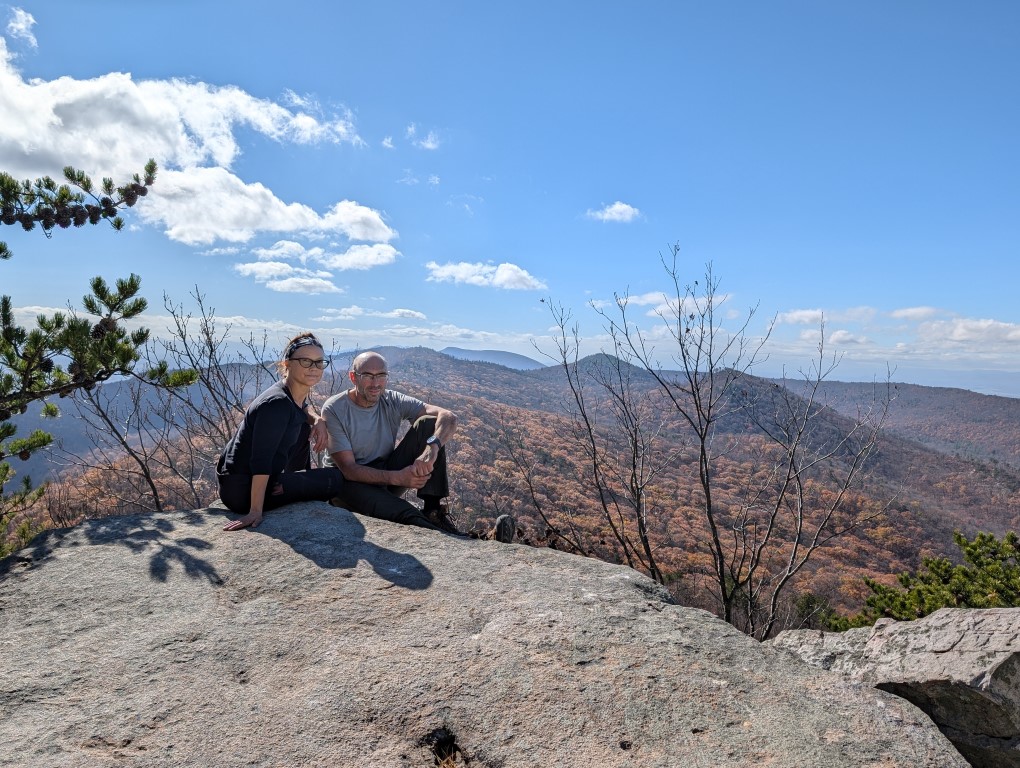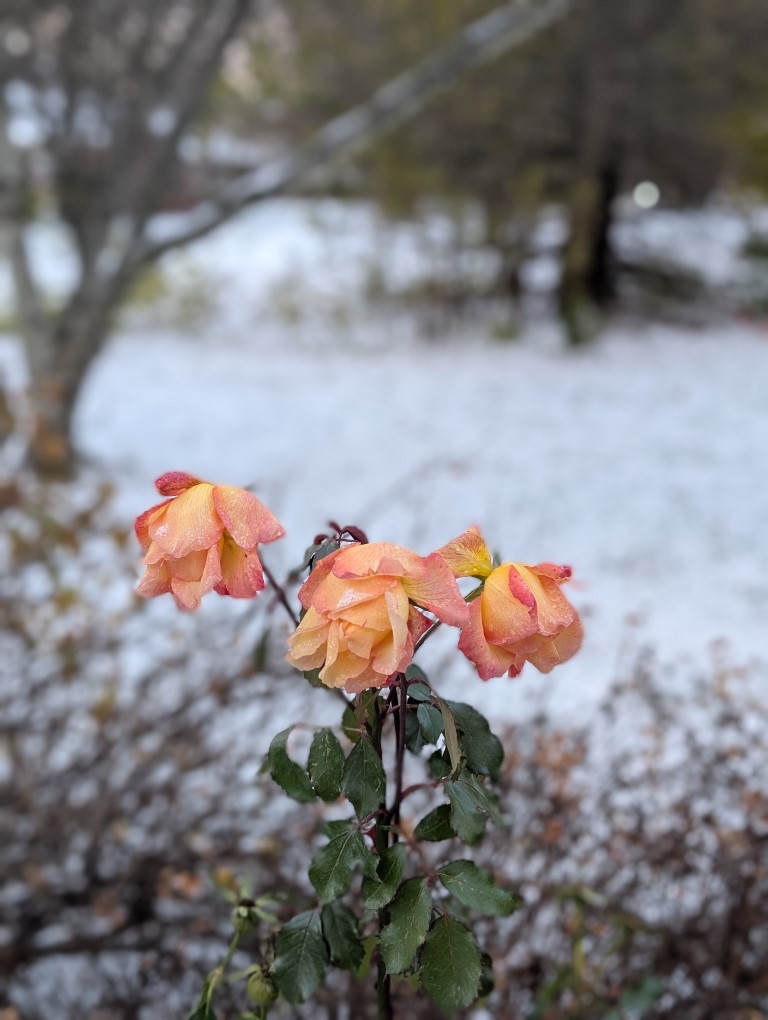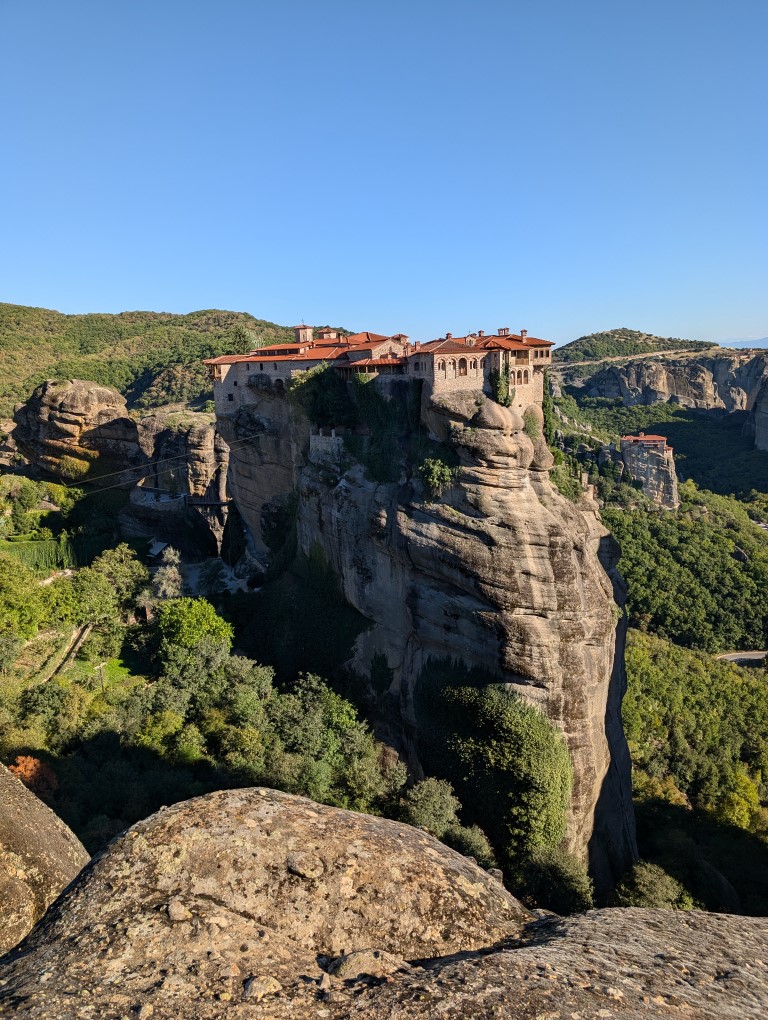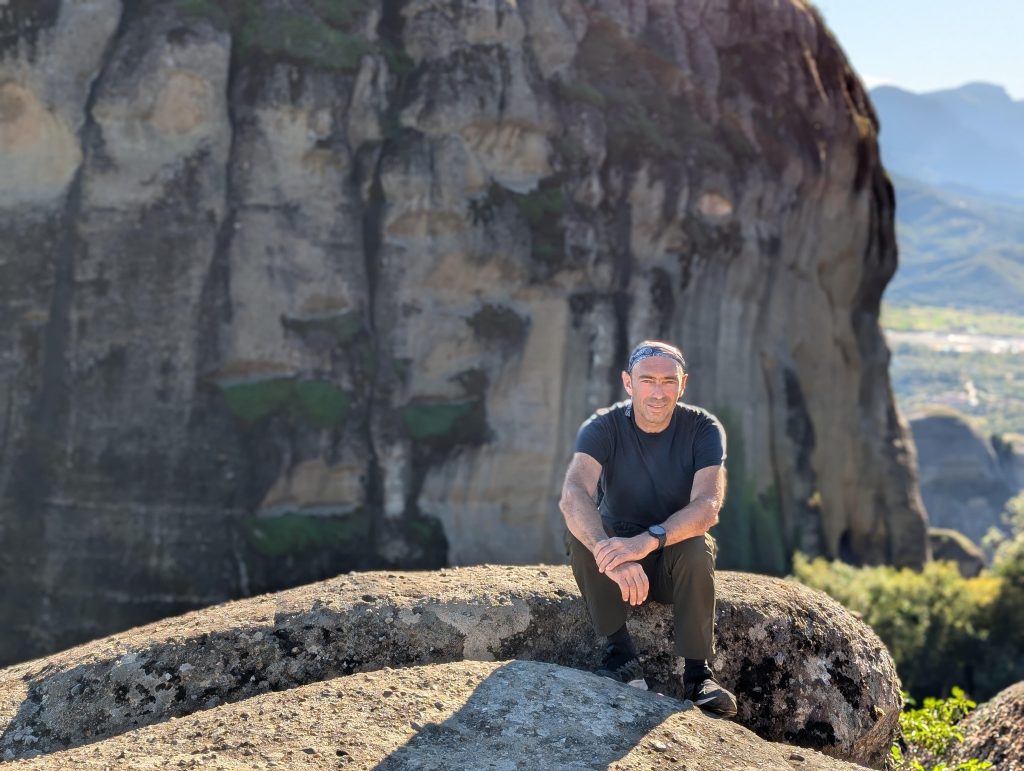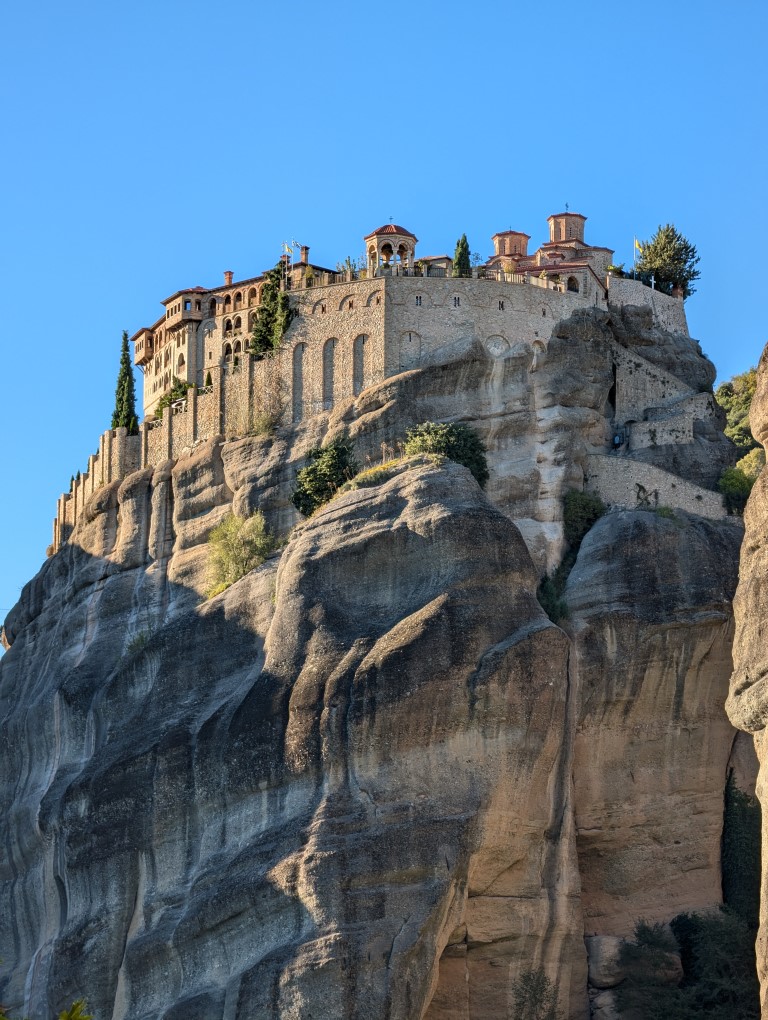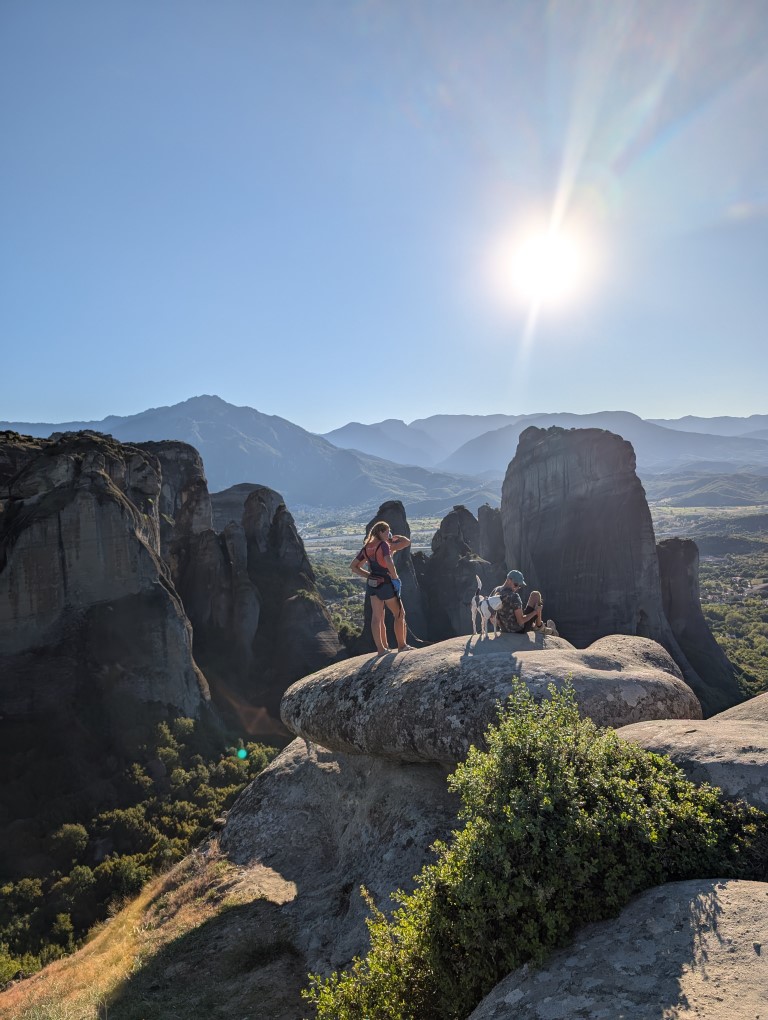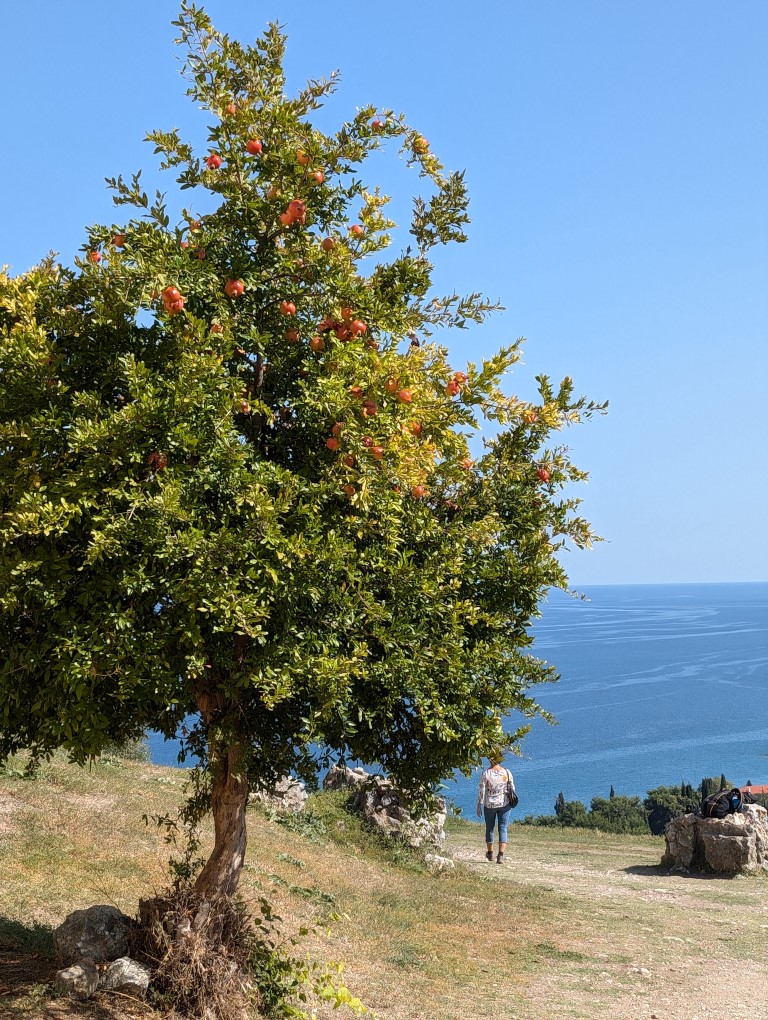Mikro Papingo. Vikos Gorge.
Our stay in the mountain villages, in Denis's and my shared opinion, left one of the most vivid impressions.
Here you won't find large, expensive hotels, noisy entertainment venues, or loud music. The cobbled streets climb steeply, sometimes up, sometimes down.  The garden plots descend in terraces over several levels, clinging to the mountain slopes.
The garden plots descend in terraces over several levels, clinging to the mountain slopes. In our understanding, in a village everything is made of wood, but here it’s the opposite, everything is made of stone, although there is no shortage of trees.
In our understanding, in a village everything is made of wood, but here it’s the opposite, everything is made of stone, although there is no shortage of trees. Even the roofs, unlike those of coastal villages, are covered in gray slate. But the village doesn't appear gloomy from the abundance of stone. On the contrary, it's located in such a beautiful spot that the natural surroundings seem to frame the stone streets and houses beautifully. Or is it the other way around? Three peaks loom directly above the village.
Even the roofs, unlike those of coastal villages, are covered in gray slate. But the village doesn't appear gloomy from the abundance of stone. On the contrary, it's located in such a beautiful spot that the natural surroundings seem to frame the stone streets and houses beautifully. Or is it the other way around? Three peaks loom directly above the village.  This is the first thing you notice when you approach the village. In the evening light, they glow pink like strawberry ice cream. In fact, in these parts, wherever you look, there are mountains.
This is the first thing you notice when you approach the village. In the evening light, they glow pink like strawberry ice cream. In fact, in these parts, wherever you look, there are mountains.  Near and far, you can gaze at them endlessly. The overall picture is further enhanced by the fact that each house has a small garden, vegetable patch, and flower garden. We thought there were no vineyards in the mountains, but we were wrong.
Near and far, you can gaze at them endlessly. The overall picture is further enhanced by the fact that each house has a small garden, vegetable patch, and flower garden. We thought there were no vineyards in the mountains, but we were wrong. Grape vines spread freely along the stonework, crossing from one side of the narrow street to the other, creating a shady passage. In one of them, the scent of grapes was so strong that we couldn't help but slow our pace to inhale deeply and absorb the sweet aroma of the berries. In another such grape tunnel, we nibbled on a berry or two, knowing they weren't ours, but unable to resist the temptation.
Grape vines spread freely along the stonework, crossing from one side of the narrow street to the other, creating a shady passage. In one of them, the scent of grapes was so strong that we couldn't help but slow our pace to inhale deeply and absorb the sweet aroma of the berries. In another such grape tunnel, we nibbled on a berry or two, knowing they weren't ours, but unable to resist the temptation.
We pull into a parking lot on the outskirts of the village. That's it, we can't drive any further because the streets are too narrow. We set out on a light "reconnaissance mission" and find our hotel in a maze of streets. They offer a special service: the owner rides an ATV down to the parking lot and delivers our suitcases to our room.
We set out on a light "reconnaissance mission" and find our hotel in a maze of streets. They offer a special service: the owner rides an ATV down to the parking lot and delivers our suitcases to our room.
The inn has retained distinctive elements of its rustic interior. Everything exudes a sense of solidity and simplicity. We see massive, iron-bound entrance doors, a roughly constructed but very large bed, two fireplaces with cast-iron dampers, and wooden shutters on the windows. The hotel has a large dining room where you'll be served a hearty breakfast. This room is decorated with traditional Greek embroidery, local shepherds' clothing, and fine wooden furniture. The courtyard is particularly charming. It's enclosed on two sides by the hotel building and outbuildings, while the other half is a small terrace with a couple of tables and a stunning view of the mountains. The courtyard is partly covered with grape vines and flowers, partly with clotheslines, where, incidentally, some guests' rather expensive hiking clothes hang, and a pair of equally expensive boots rest on a stone press.
The hotel has a large dining room where you'll be served a hearty breakfast. This room is decorated with traditional Greek embroidery, local shepherds' clothing, and fine wooden furniture. The courtyard is particularly charming. It's enclosed on two sides by the hotel building and outbuildings, while the other half is a small terrace with a couple of tables and a stunning view of the mountains. The courtyard is partly covered with grape vines and flowers, partly with clotheslines, where, incidentally, some guests' rather expensive hiking clothes hang, and a pair of equally expensive boots rest on a stone press.
The hotel's exterior further confirms our suspicions about the kind of people who enjoy staying here. People come here seeking solitude, an idyllic, unhurried pastime. They love to wander the trails all day, and later, in the evening, sit on the terrace in the small restaurant, eating delicious food, washing it down with wine, and watching the sunset over the mountains. We recognize ourselves in them.
After checking into the hotel, we leave our things and go for a walk around the area.  We can't go far, because it's getting late and a blue shadow has already settled down in the gorge below. But up above, the sun is still out, and there's time to stroll through the village streets.
We can't go far, because it's getting late and a blue shadow has already settled down in the gorge below. But up above, the sun is still out, and there's time to stroll through the village streets. It's very small, with no infrastructure: no school, no hospital, no post office, not even a store. There's just a small church, a few hotels similar to ours, and two or three restaurants. At the end of our walk, we were rewarded with a sunset, the kind you only get in the mountains.
It's very small, with no infrastructure: no school, no hospital, no post office, not even a store. There's just a small church, a few hotels similar to ours, and two or three restaurants. At the end of our walk, we were rewarded with a sunset, the kind you only get in the mountains. Now it's time to return to the hotel, so as not to get lost in the dark among the narrow streets. Especially since we need to prepare everything for tomorrow's journey.
Now it's time to return to the hotel, so as not to get lost in the dark among the narrow streets. Especially since we need to prepare everything for tomorrow's journey.
As darkness fell in our room, we suddenly felt the distinct feeling of October in the mountains and began to feel a little chilly. After a fruitless search for the heating control panel, we decided to take a quick hot shower, drink some herbal tea we'd picked on our walk, and crawl under the blankets. Oddly enough, despite two real fireplaces and two layers of blankets, it wasn't even remotely warm. We had to put on sweaters and pants, as there were no warm pajamas.
The day before, we'd agreed with our hosts that we needed an early breakfast the next morning and that they'd take us to the exit point into the Vicos Gorge. I'd seen that name before... Where? Oh, right! On the label of a water bottle. So that's where they get that water.
The hostess feeds us such a breakfast that even half of it is more than enough for me. But we absolutely need to eat to have the strength for the day's journey through the Vikos Gorge. That's our plan for today.
October 2
When you're driving along the most picturesque serpentine road with a local, it's not so scary. The driving style of Jorge, the innkeeper, is practiced and honed over the years. He accelerates smoothly on flat roads and brakes gently on curves. And there are so many of them here! Jorge steers with feigned nonchalance, one-handed, while simultaneously checking something on his phone. But for some reason, you really wish our driver would hold the wheel with both hands and keep his eyes on the road, not his phone.
In response to our nervous reaction, Jorge puts down his phone and we start a conversation about the peculiarities of life in a Greek mountain village.
- Do you like your Toyota? By the way, we also have a Toyota.
- Yes, the Toyota is a good car. It handles great in the mountains. My business was picking up, so I bought it.
- Do many people come?
- Yes, during the “dry season” many tourists come, especially from Europe.
- And the Greeks?
- Locals come in winter and spring because prices are much lower.
So we drive for about fifty minutes to the start of the trail. 
The weather is great! While it was quite chilly early in the morning, it became quite comfortable around nine o'clock.
There is no one else on the trail except us.  The walking is easy because our route runs along a dry spring bed in a deep gorge. Only the occasional large boulders and slippery pebbles are encountered. The rocks on both sides and the trees along the spring bed provide pleasant shade.
The walking is easy because our route runs along a dry spring bed in a deep gorge. Only the occasional large boulders and slippery pebbles are encountered. The rocks on both sides and the trees along the spring bed provide pleasant shade.  I constantly want to stop and capture the beauty around us. We travel light. Our small backpack contains only two bottles of water and a snack for lunch. A little later, we move our jackets in, which are getting hot.
I constantly want to stop and capture the beauty around us. We travel light. Our small backpack contains only two bottles of water and a snack for lunch. A little later, we move our jackets in, which are getting hot. Some time later, we encounter a group of elderly Frenchmen. We greet them with a friendly "bonjour" and easily overtake them. A cross-country runner, in turn, easily and casually overtakes us. Everyone has their own speed. And another man we meet isn't going anywhere at all. He's sitting on a rock, writing something by hand in a paper notebook. I can't resist asking:
Some time later, we encounter a group of elderly Frenchmen. We greet them with a friendly "bonjour" and easily overtake them. A cross-country runner, in turn, easily and casually overtakes us. Everyone has their own speed. And another man we meet isn't going anywhere at all. He's sitting on a rock, writing something by hand in a paper notebook. I can't resist asking:
- Kalimera! What are you writing, if it's not a secret?
The wanderer looks up from his work and readily replies:
- I write travelogues! And I recommend you do too! You'll find them interesting to reread in twenty years.
- "We already are!" we answer almost in chorus.
It turns out that this man is a native of Wales.
- "Where are you from?" he asks curiously. "From America? Your accent... Oh, you're originally from Russia?! What do you think about the war between Russia and Ukraine?"
The talkative Englishman literally bombards us with questions about international issues, drawing us into a discussion.
The devil made me start a conversation! How chatty the English can be sometimes! Denis is ready to continue the conversation, but I literally drag him further down the path.
- "This is such a peaceful place, let's not talk about war," I say to the Englishman. "Besides, we need to move on.".
- "What do you think of Putin's policies?" he shouts after her.
But we no longer “hear” the question, we wave goodbye and quickly leave.
Well, really, this is the most inappropriate place for a conversation about political topics.
We move on and at some point the trail turns sharply upward. There are open, treeless areas with rocky scree. We traverse a narrow trail. It's crucial not to trip or slide down the steep slope. This section was short, but perhaps the most difficult. Moreover, the sun was blazing, and there was nowhere to hide. Our efforts were rewarded with a beautiful view of the gorge and the nearby cliffs, like fingers jutting from the earth's crust.
There are open, treeless areas with rocky scree. We traverse a narrow trail. It's crucial not to trip or slide down the steep slope. This section was short, but perhaps the most difficult. Moreover, the sun was blazing, and there was nowhere to hide. Our efforts were rewarded with a beautiful view of the gorge and the nearby cliffs, like fingers jutting from the earth's crust. At the top, we decided to rest, have lunch, and check how much further we had to go. It turned out we'd covered most of the way quite briskly, and there were no more than an hour and a half left to go. Again, we shouldn't skimp on water, as there would be streams along the way.
At the top, we decided to rest, have lunch, and check how much further we had to go. It turned out we'd covered most of the way quite briskly, and there were no more than an hour and a half left to go. Again, we shouldn't skimp on water, as there would be streams along the way.
We traveled the rest of the way without any major adventures, enjoying yet another dose of beautiful scenery. Only at the end of the journey, on the outskirts of our village, did we stop at a spring to drink and take home a full bottle of delicious water. 
 In the end, we completed the fifteen-kilometer route through rough terrain in six hours. Not a bad result! The owner even applauded us and said, "Bravo.".
In the end, we completed the fifteen-kilometer route through rough terrain in six hours. Not a bad result! The owner even applauded us and said, "Bravo.".
Now it's time to take a break for an hour, have some tea, and then head to the neighboring village. We're really not that keen on going, we're tired after all, but there are a couple of stimuli that compel us to pull ourselves together and head to Megalo Papingko. We're going to withdraw cash to pay the owner for the morning ride and also to get some well-deserved ice cream, as there's no ATM or ice cream parlor in our village. We could, of course, drive our own car, but that's not our style.
We hadn't done much walking that day, just seventeen kilometers through mountains and valleys, so after ice cream we went to see the large village of Megalo Papingko. Although it's larger, the overall "abandonment" of the houses is more striking. There are restaurants and cafes, but they're all empty. This is probably because the "wealthy foreign tourist" season is ending. The streets are almost deserted. One thing amazes me: no matter how small or large a Greek town, there's always a well-kept church/bell tower/monastery with an old plane tree nearby.
This is probably because the "wealthy foreign tourist" season is ending. The streets are almost deserted. One thing amazes me: no matter how small or large a Greek town, there's always a well-kept church/bell tower/monastery with an old plane tree nearby. Most often, this is a very ancient religious building and the tree is the same age as it.
Most often, this is a very ancient religious building and the tree is the same age as it.
We return to our village at sunset. We're already craving something more substantial than just ice cream. We sit on the restaurant terrace, have dinner, and watch the sunset over the mountains. 
There's a famous Latin proverb: "You can watch three things forever: fire burning, water flowing, and other people working." I'd change the last one to "the sun setting in the mountains.".
A gray kitten sitting on a stone fence is seeing off the sun. Or rather, he's seeing off the lamb as it disappears into our mouths. He looks at us in a way that makes the piece stick in your throat, making you want to share it right away. Then, as if by magic, the kittens double in number. Oh, no, guys, there won't be enough for everyone; we've earned this dinner honestly. First come, first served.
It's getting chilly; it's October after all. I need to get to bed early and leave tomorrow at eight in the morning, because rain is forecast. And the most picturesque serpentine road automatically turns into the most dangerous if you're not a native of these parts.
We leave the Greek mountain village of Mikro Papingo on a gloomy morning on October 3rd. A few minutes after leaving, it becomes clear that Denis and I are thinking about the same thing: it would be nice to come back here again.
A few minutes after leaving, it becomes clear that Denis and I are thinking about the same thing: it would be nice to come back here again.
Go to Greek Trip Homepage.


